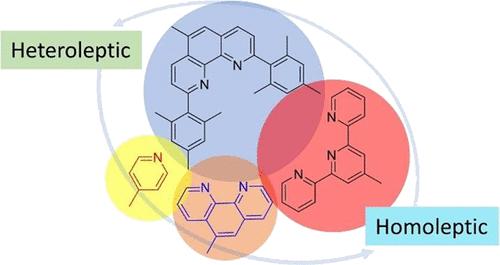从宏观流变学特征解码金属超分子聚合物网络中的配位几何强化
IF 5.1
1区 化学
Q1 POLYMER SCIENCE
引用次数: 0
摘要
控制金属超分子聚合物网络中的配位几何不仅有助于开发新的聚合物结构,还能提供衡量金属复合物特性的新方法。在此,我们比较了单配体、双配体和三叉配体通过同配体和异配体结合获得的网络的多尺度特性,这些特性反映在流变学测量和 DFT 计算中。因此,与吡啶、菲罗啉和特吡啶官能化的四臂聚(乙二醇)(tetraPEG)形成了母体同oleptic 网络,而它们与由立体上要求苛刻的二甲苯取代菲罗啉官能化的四臂聚(乙二醇)结合则形成了异oleptic 网络。在所有使用的过渡金属离子中,只有 Cu+/2+ 和 Pd2+ 符合所有母体和混合网络的配位几何要求,从三面体到八面体,为广泛的网络拓扑重排提供了良好的候选。我们的流变学测量和 DFT 计算表明,同配位复合物的稳定性主要取决于金属特性,而异配位复合物的稳定性则随着纤细配体齿性的增加而增加,这是立体、电子和 π-π 相互作用的复杂函数。本文章由计算机程序翻译,如有差异,请以英文原文为准。

Decoding Coordination Geometry Enforcement in Metallo-supramolecular Polymer Networks from Macroscopic Rheological Signatures
The control over coordination geometry in metallo-supramolecular polymer networks not only helps developing new polymer structures but also provides new measures of metal complex characteristics. Herein, we compare multiscale characteristics of networks obtained by homo- and heteroleptic association of mono-, bi-, and tridentate ligands, as reflected in rheological measurements and DFT calculations. Accordingly, tetra-arm poly(ethylene glycol) (tetraPEG), functionalized with pyridine, phenanthroline, and terpyridine, form parent homoleptic networks, while their combination with a tetraPEG functionalized by the sterically demanding dimesitylene substituted phenanthroline forms heteroleptic networks. Among all employed transition metal ions, only Cu+/2+ and Pd2+ comply with the coordination geometry necessities of all parent and mixed networks, ranging from trigonal to octahedral, providing good candidates for wide network topology rearrangements. Our rheological measurements and DFT calculations demonstrate that the stability of homoleptic complexes depends primarily on metal identity, whereas that of heteroleptic equivalents increases with increasing the denticity of the slim ligand, being a complex function of steric, electronic, and π–π interactions.
求助全文
通过发布文献求助,成功后即可免费获取论文全文。
去求助
来源期刊

Macromolecules
工程技术-高分子科学
CiteScore
9.30
自引率
16.40%
发文量
942
审稿时长
2 months
期刊介绍:
Macromolecules publishes original, fundamental, and impactful research on all aspects of polymer science. Topics of interest include synthesis (e.g., controlled polymerizations, polymerization catalysis, post polymerization modification, new monomer structures and polymer architectures, and polymerization mechanisms/kinetics analysis); phase behavior, thermodynamics, dynamic, and ordering/disordering phenomena (e.g., self-assembly, gelation, crystallization, solution/melt/solid-state characteristics); structure and properties (e.g., mechanical and rheological properties, surface/interfacial characteristics, electronic and transport properties); new state of the art characterization (e.g., spectroscopy, scattering, microscopy, rheology), simulation (e.g., Monte Carlo, molecular dynamics, multi-scale/coarse-grained modeling), and theoretical methods. Renewable/sustainable polymers, polymer networks, responsive polymers, electro-, magneto- and opto-active macromolecules, inorganic polymers, charge-transporting polymers (ion-containing, semiconducting, and conducting), nanostructured polymers, and polymer composites are also of interest. Typical papers published in Macromolecules showcase important and innovative concepts, experimental methods/observations, and theoretical/computational approaches that demonstrate a fundamental advance in the understanding of polymers.
 求助内容:
求助内容: 应助结果提醒方式:
应助结果提醒方式:


